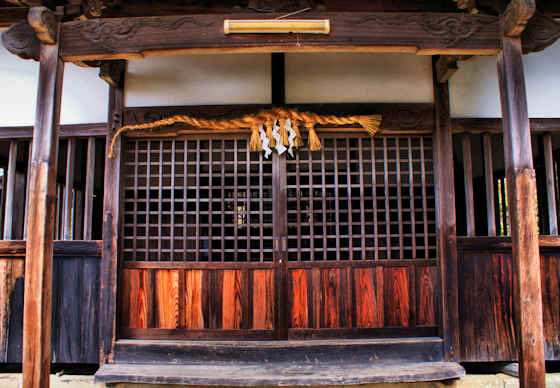Showing posts with label suwa. Show all posts
Showing posts with label suwa. Show all posts
Friday, June 13, 2025
Suwa Shrine & Mikiinari Shrine Kobe
Monday, January 29, 2024
Shrines of Day 66
While walking around the countryside near Sasebo in Nagasaki on the 66th day of my walk along the Kyushu pilgrimage I stopped in at any shrines that I passed. At the start of the day I visited a largish Sumiyoshi shrine in Haiki, and a little later Hasami Shrine next to Tozenji Temple. All the other shrines I visited that day were quite small and no information boards.
Just 100 meters away is Srayama Daijingu Shrine. The small hokora was established in 1487. Unusual was a horse and a komainu rather than 2 komainu.
Sunday, February 23, 2014
Torii Tunnels
Lines of red torii placed so close together they form a tunnel are a common sight throughout Japan. The most famous and most photographed are at the Fushimi Inari Shrine near Kyoto, but smaller versions can be found all over at shrines and temples.
They are usually made of wood, occasionally steel, but more often nowadays plastic pipe is being used. Each torii will have been paid for by a donation, and the name of the donor is usually written on each, similar to how some shrines will have lines of more expensive stone lanterns.
The top photo is from the Inari Shrine in the grounds of Suwa Shrine, Nagasaki. The second photo is at Tadaji Temple in Hamada. The third is a small Inari hokora near Kokura Castle.
The photo above is an Inari shrine in the grounds of the Hitomaro Shrine in Masuda.
If the Inari shrine is on a hillside, like at Fushimi, then the torii tunnels will switchback up the hillside like the photo above taken at the Taikodani Inari Shrine in Tsuwano.
Thursday, February 9, 2012
A Second Suwa Shrine in Itano Town
Only about 3k from another Suwa Shrine, this second one in Itano Town, Tokushima, has a huge camphor tree at the entrance.
Believed to be around 700 years old, this venerable kusonoki grows to more than 35 meters in height.
The enshrined kami at Suwa shrines are Takeminakata, the son of Okuninushi who refused to hand over Izumo to the Yamato, and his wife Yasakatome. By the Heian Period the kami was called by the name of Suwa Myojin, the "bright shining deity of Suwa.
The cult of Suwa Myojin spread far and wide due to its association with, among other things, wind, hunting, and battle, though its spread is most likely due to the samurai who worshipped it as a kami of battle.
Labels:
henro,
Shrine,
suwa,
takeminakata,
tokushima
Wednesday, December 21, 2011
Suwa Shrine, Itano
Suwa Shrine in Itano, Tokushima, is located between temples 2 & 3. It is one of the approximately 10,000 branch shrines of Suwa Taisha up in Nagano.
The grounds were pretty unkempt and it looked as if the shrine was not used by people much.
The main kami enshrined in Suwa shrines are Takeminakata and his wife Yasakatome. According to the legend he was a son of Okuninushi who did not wish to hand over the land to the emissaries sent by Amaterasu. he challenged one of them to a trial of strength and was defeated. This is considered to be the mythological origin of sumo. He fled to Suwa in what is now Nagano.
The legend would seem to indicate that there was resistance within the confederacy of tribes/clans/countries that centered on Izumo to the takeover by the Yamato.
Labels:
kuniyuzuri,
shikoku,
Shrine,
suwa,
takeminakata,
tokushima,
yasakatome
Wednesday, May 5, 2010
The diverse Komainu of Suwa
Komainu, the pairs of guardian "lion/dogs" that guard the entrance to shrines, come in a variety of styles and forms. All the ones depicted here are found inside the grounds of Suwa Shrine in Nagasaki.
This was the first time I have ever seen one standing on its hind legs...
Though its partner I have seen before on a temple roof.
One of the pair always has its mouth open, the other its mouth closed.
Suwa is an interesting shrine . It was established in the seventeenth Century expressly to combat the influence of Christianity.
The pairs are seen as male/female, and the open and closed mouth represent the "a" and "un" sounds (equivalent to Alpha and Omega).
The most famous pair at Suwa is probably the ones known as "Stop Lions". One wraps a string or thin strip of paper around their legs when praying to stop something, like smoking.
As the komainu age they become weathered, moss covered, and sometimes damaged, all of which contributes to their strange appearance sometimes.
The money washing komainu is another that I had never seen before. Apparently washing your money here will cause it to double.
The Turntable Komainu is one a circular stone base that you spin around as you make your request. It was used by local prostitutes to pray for bad weather that would keep the sailors, their customers, in port longer.
Subscribe to:
Posts (Atom)












































